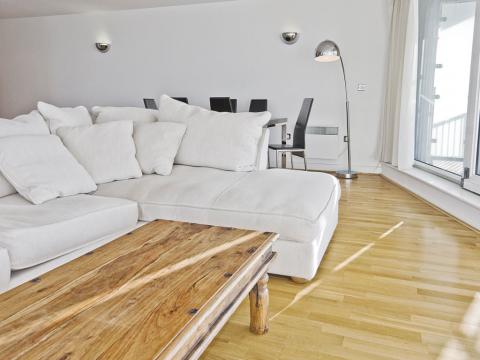How do tariffs impact prices and selection at Whole Wood? Find out here.
Unfinished Hardwood Flooring

Unfinished Hardwood Flooring - Customizable and Timeless
What is Unfinished Hardwood Flooring?
Unfinished Hardwood Flooring is a versatile option for homeowners and contractors seeking maximum customization and durability. Unlike Pre-finished Hardwood, Unfinished Flooring requires sanding, staining, and sealing on-site after installation, allowing for a seamless, uniform look tailored to your specific needs.
Unfinished Hardwood is typically:
- 3/4" thick with tongue-and-groove construction.
- Available in widths from 2-1/4" to 5", with wider planks available by special order.
- Supplied in random lengths, ranging from 12" to 78".
- Installed over approved plywood subfloors, on or above grade (not in basements).
Grades of Unfinished Hardwood Flooring
Unfinished Hardwood Flooring is available in several grades, each offering unique aesthetics:
Clear / 1st Grade
- The cleanest option with minimal color variation and no knots.
- Longer average board length (around 3 feet).
- Ideal for creating a sleek, high-end look.
Select & Better / 2nd Grade
- More color variation with occasional pin knots and sticker stains.
- Medium board length (average 2.5 feet).
- Offers a balance of character and elegance.
Natural / 3rd Grade
- Includes mineral streaks, sticker stains, and solid knots of varying sizes.
- Shorter average board length (around 2 feet).
- Perfect for rustic or natural designs with more character.
When to Choose Unfinished Hardwood Flooring
Unfinished hardwood flooring is a great fit for:
- Customization: Allows you to create unique colors, textures, or finishes.
- Matching Existing Floors: Perfect for extending existing hardwood seamlessly.
- Historic Renovations: Ideal for restoring period-appropriate aesthetics in older homes.
- Uneven Surfaces: Sanding on-site ensures a level and consistent finish.
- Large Spaces: Offers a uniform look across expansive areas.
- Specialized Designs: Flexible for intricate inlays, borders, or custom patterns.
Advantages of Installing Unfinished Hardwood Flooring
Unfinished Hardwood Flooring offers a range of benefits over pre-finished options:
- Uniform Finish: Sanding and staining on-site ensures a seamless, bevel-free surface.
- Color Consistency: Achieve perfectly matched hues across the entire floor.
- Easier Repairs: Future refinishing is simpler and more seamless.
- Custom Finishes: Choose matte, glossy, or mix stains for a unique color.
- Longevity: Sand and refinish multiple times, extending the floor’s lifespan.
- Cost-Effectiveness: Durable and easy-to-repair, making it a long-term investment.
Popular Wood Species for Unfinished Hardwood Flooring
Unfinished flooring is available in many species, allowing for a wide range of styles:
- White Oak: Classic, light tones perfect for modern or traditional homes.
- Walnut: Rich, dark hues with a luxurious feel.
- Maple: Smooth grain and light color for a clean, contemporary look.
- Santos Mahogany: Exotic reddish-brown tones for bold elegance.
- Brazilian Cherry: Vibrant hues with unique grain patterns for added character.
Why Choose Whole Wood for Unfinished Hardwood Flooring?
Located in San Carlos, Whole Wood offers:
- The Best Selection of Unfinished Hardwood Flooring in the San Francisco Bay Area.
- Competitive pricing on premium grades and wood species.
- Expert guidance to help you achieve your design vision.
- TRANSFORM YOUR HOME with Unfinished Hardwood Flooring.
Unfinished hardwood flooring offers unmatched versatility, allowing you to create a custom look that fits your unique style and needs. Visit our showroom or contact us today to explore our extensive selection.
Plan Your Visit Today!
- 1100 Industrial Rd #17, San Carlos, CA 94070
- Get Directions to Showroom + Warehouse
- Call Us! 650.654.8880
Call Whole Wood! 650.654.8880
Get up to $50 off your purchase!
Whole Wood will meet or beat any price!
